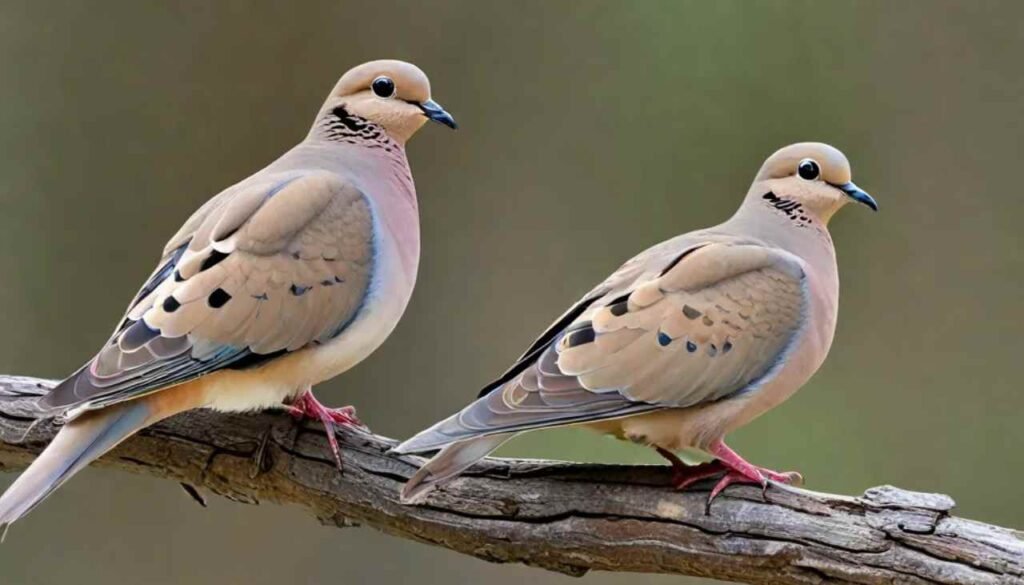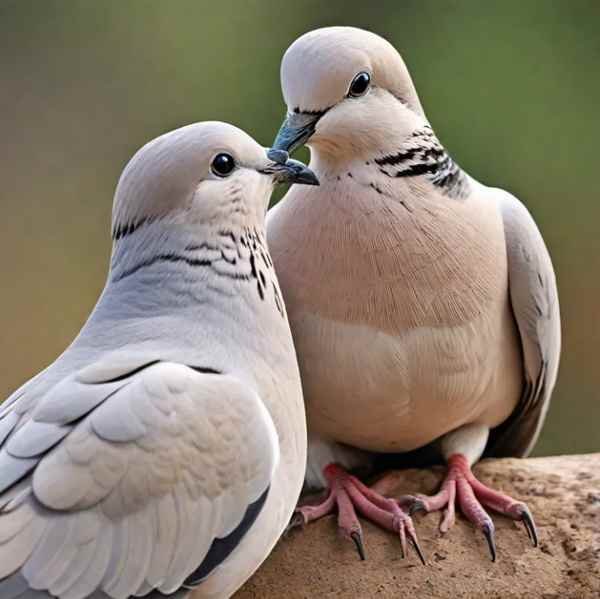Doves, known for their calm coo and smooth flying, are often seen in numerous American backyards. But did you ever question whether the doves you spot are male or female? Though they seem alike at first, small differences exist between male and female doves. Knowing these unique points can make the intriguing universe of these feathered pals even more enjoyable.
Overview of Sexual Dimorphism in Doves
| Characteristic | Male Doves | Female Doves |
|---|---|---|
| Size | Usually a bit bigger, a touch more elegant. | Often slightly smaller and stockier |
| Plumage | Colors tend to pop more, especially on the head, neck, and chest with a sheen that catches the eye. | Duller, more muted colors |
| Beak and Feet (optional) | Changes in hue or size are sometimes noticeable. | Less variation compared to males |
| Behavior (breeding season) | You’ll often see them doing intricate dances of love – puffing up their chest, nodding their head, calling out in strong tones. | Less conspicuous behavior |
| Nesting | They might help create nests. | Takes primary responsibility for incubation |
| Vocalizations (optional) | Their calls can demand attention, not stopping, and full of mixed sounds. | Coos may be quieter and simpler |

How to identify dove male or female?
Physical Differences
Doves, like other birds, show tiny differences between males and females. These differences aren’t always obvious, but they can be noticed in their size, color, and sometimes their beak and feet. Let’s break this down a bit.
- Size and Build: Imagine a Mourning Dove, a common US species. The females generally appear to be a bit smaller and leaner than males. However, this size change is often hard to spot. Scientists call these gender-based physical alterations “sexual dimorphism.” They believe this is due to differences in mating roles.
- Coloration: This is commonly the clearest difference. Male doves characteristically have colorful feathers, especially on their heads and necks. For example, male Mourning Doves stand out with a rosy-pink breast and a bluish-gray crown. Contrarily, females don’t have these bright colors, instead, their plumage is more of a brownish-gray color. These color differences probably help with attracting mates. Males use their flashy colors to show their health and fitness to females.
- Beaks and Feet (Optional): Sometimes doves might showcase minor variations in beak color or size. As an example, male Inca Doves own a reddish-orange beak, whereas females have a more muted brown beak. But these types of differences don’t happen as frequently as variations in size and color.

| Feature | Male Doves | Female Doves |
|---|---|---|
| Size | Usually a bit bigger and stronger. | Slightly smaller and more slender |
| Coloration | Displays brighter, shimmering colors, especially on the head, neck, and chest. | Duller, more drab coloration overall |
| Beak (Optional) | Size and color can show minor changes depending on the species. | Typically less colorful or smaller than male beaks (species-dependent) |
| Feet (Optional) | Color change can also depend on the species. | Typically similar in color to beaks (species-dependent) |
Behavioral Differences
Male and female doves, more than just looking different, behave differently too.
- Courtship and Mating: Male doves excel in catching the eye of potential partners. They put on striking performance displays – their chests swell, their heads move up and down, and their coos fill the air. These displays fulfill two roles: they wow possible partners and tell rivals to keep away. After a female has chosen her partner, the two put their energies into nest-building and caring for their offspring.
- Nesting and Incubation: Dove nests, usually assembled from twigs and leaves, are found in trees or bushes. Both male and female may help in building the nest, although the female often directs the work. After the eggs arrive, the main job of keeping them warm falls to the female. Occasionally, the males may fill in to allow the female a chance to hunt for food.
- Vocalizations (Optional): Both male and female doves coo, but there can be slight differences. Males are usually louder, persistent, and have a more intricate coo than females. These differences might be important for attracting partners and claiming their territories.
Identification Tips
Guessing a dove’s gender in the field can be a neat puzzle for bird enthusiasts. Try the following tricks to spot the difference between male and female doves:

- Observe plumage coloration: Search for brighter, sparkly feathers on males, mostly on the head, neck, and chest. Females usually don’t have these vibrant patches.
- Pay attention to size: Even though it’s minor, females might be a bit tinier and slimmer than males.
- Watch for courtship behavior: If a dove is puffing its chest, nodding its head, and cooing loud, it’s probably a male looking for a sweetheart.
- Consider the context: In nesting season, the dove sitting on the eggs is probably the female.

Remember: Watching doves in their natural home is vital for correct identifying. Don’t depend solely on one detail, as a species can show some changes. Bring patience and sharp sight and you’ll surely tell male and female doves apart.
Importance of Understanding the Differences
Knowing how male and female doves differ isn’t just about quenching your wonder. These differences matter a lot for the birds’ reproduction and staying alive. Boy doves with colorful feathers get the girls’ attention, facilitating their breeding. At the same time, dull-colored female doves hide better when keeping eggs warm, saving them from threats.
By studying these distinctions, we learn more about the cool changes doves have made to succeed for thousands of years.
| Dove Species | Male Plumage Characteristics | Female Plumage Characteristics | Size Difference (Male vs. Female) |
|---|---|---|---|
| Mourning Dove | Rosy-pink breast, bluish-gray crown | Brownish-gray overall | Male slightly larger and more slender |
| Rock Dove (Common Pigeon) | Iridescent green and purple feathers on neck and breast | Duller overall plumage, lacks iridescence | Male larger and more robust |
| White-winged Dove | Large pinkish-red patch on breast | No breast patch | Similar size |
| Inca Dove | Reddish-orange beak | Brown beak | Similar size |
Let’s crack into birdwatching with doves. They’re quite common and easy to spot in your backyard, park, or any green landscape. With just a bit of skill, you’ll quickly catch on and differentiate between various dove species and genders. Plenty of top-notch birdwatching resources are out there. Check out the National Audubon Society’s website and the Cornell Lab of Ornithology. Lots of dove tips there! Want to ID them correctly? Find out about their habits and likes? It’s all in these resources.
Here are few more doves that are regulars in the United States, each with unique traits:
- Rock Dove (Common Pigeon): They have more obvious differences between males and females than most dove species. Male Rock Doves sport shiny green and purple plumage on their necks and chests. On the other hand, females are less colorful.
- White-winged Dove: Yet, males display a large pinkish-red patch on their chests. Female White-winged Doves don’t have this splash of color.
- Mourning Dove: Males feature a pink chest and a bluish-gray head, while females have a more uniform brown-gray tone.
- Inca Dove: You can spot a small change in its beak color based on whether it’s a male or a female. Males sport a reddish-orange beak. Females, on the other hand, carry a brown one.
Beyond Gender Differences: Sex impacts how doves look and act a lot. But still, it’s not the only thing. A dove’s age, where it lives, and its own unique traits can change its feather colors and how it behaves. Like, a young boy dove might not have his full ‘breeding’ outfit yet. The more you watch and learn, the better you’ll get at seeing these little differences.
Conclusion
In summary, at first, doves may all look alike. But when you look closely, you’ll see some exciting details. Males and females have differences that you can see. Males are usually larger and their feathers are brighter. Their heads and necks especially stand out. Females, on the other hand, have muted, plain feathers. Beyond that, they also act differently. Males do a dance to get a mate’s attention. When it comes to nesting, females mainly incubate the eggs, but both can help build the nest. These differences are important. They tell us who is male and who is female. They also show us how important each role is in making sure doves continue to exist. Males’ bright feathers attract females for mating. Females’ drab feathers help hide them while they protect their eggs from danger. These differences remind us how wonderfully adapted doves are to survive. They’ve been doing it for thousands of years.

